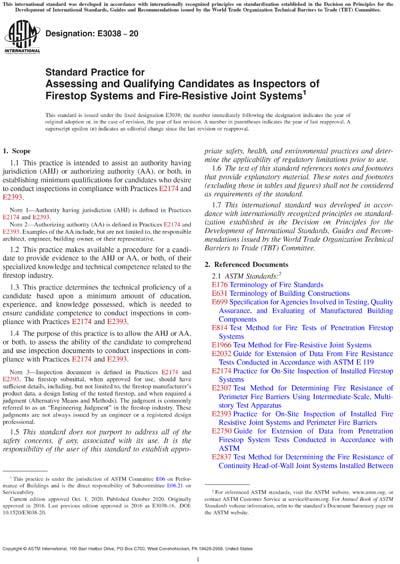Historical
ASTM E3038-20
Standard Practice for Assessing and Qualifying Candidates as Inspectors of Firestop Systems and Fire-Resistive Joint Systems
1.1 This practice is intended to assist an authority having jurisdiction (AHJ) or authorizing authority (AA), or both, in establishing minimum qualifications for candidates who desire to conduct inspections in compliance with Practices E2174 and E2393.
Note 1: Authority having jurisdiction (AHJ) is defined in Practices E2174 and E2393.
Note 2: Authorizing authority (AA) is defined in Practices E2174 and E2393. Examples of the AA include, but are not limited to, the responsible architect, engineer, building owner, or their representative.
1.2 This practice makes available a procedure for a candidate to provide evidence to the AHJ or AA, or both, of their specialized knowledge and technical competence related to the firestop industry.
1.3 This practice determines the technical proficiency of a candidate based upon a minimum amount of education, experience, and knowledge possessed, which is needed to ensure candidate competence to conduct inspections in compliance with Practices E2174 and E2393.
1.4 The purpose of this practice is to allow the AHJ or AA, or both, to assess the ability of the candidate to comprehend and use inspection documents to conduct inspections in compliance with Practices E2174 and E2393.
Note 3: Inspection document is defined in Practices E2174 and E2393. The firestop submittal, when approved for use, should have sufficient details, including, but not limited to, the firestop manufacturer’s product data, a design listing of the tested firestop, and when required a judgment (Alternative Means and Methods). The judgment is commonly referred to as an “Engineering Judgment” in the firestop industry. These judgments are not always issued by an engineer or a registered design professional.
1.5 This standard does not purport to address all of the safety concerns, if any, associated with its use. It is the responsibility of the user of this standard to establish appropriate safety, health, and environmental practices and determine the applicability of regulatory limitations prior to use.
1.6 The text of this standard references notes and footnotes that provide explanatory material. These notes and footnotes (excluding those in tables and figures) shall not be considered as requirements of the standard.
1.7 This international standard was developed in accordance with internationally recognized principles on standardization established in the Decision on Principles for the Development of International Standards, Guides and Recommendations issued by the World Trade Organization Technical Barriers to Trade (TBT) Committee.
ASTM International [astm]

